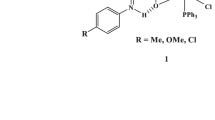Abstract
The behaviour of complexes of the type MeD2I2 (Me=Co,D = acetylacetone or benzoylacetone,I = imidazole and derivatives in the course of the stepwise thermal degradation is different. In the case ofD = acetylacetone in the first step acetylacetone is split off. At D = benzoylacetone the decomposition starts with the partial elimination of the heterocyclic ligands.
InΒ-position unsubstituted nickelacyclic complexes from type (bipy)Ni(CH2CH2CH2COO) decompose by a reductive elimination and separating of CO2 forming a ‘(bipy)Ni’-intermediate. A single reductive decoupling is hindered by blocking up theΒ-position.
Opposite to the high thermal stability of the trimesityl aluminium the intermediates Almes2Cl and AlmesCl2 show with decreasing amounts of mesityl groups and increasing content of halogene, respectively, a significant decreasing thermal stability.
The thermal degradation of nickelchelates of alkylsubstituted chinolin-8-ol starts with the dehydration followed by a different separation of the ligands as a function of the chain-length and the position of the substituents of the ligands.
Zusammenfassung
Das Zersetzung Verhalten der Komplexverbindungen vom Typ C0D2I2 (P = acetylaceton, Benzoylaceton;I = Imidazol oder Derivate) erfolgt stufenweise. Im Falle vonD = Acetylaceton erfolgt zuerst eine Eliminierung von Acetylaceton wärend beiD = Benzoylaceton zuerst ein Heteroligand eine Abspaltung erfährt.
Bei einer unsubstituiertenΒ-Position von Nickelacyclen des Typs (bipy)Ni(CH2CH2CH2COO) erfolgt eine thermisch induzierteΒ-Hydrideliminierung unter Ringspaltung und Freisetzung von CO2.
Im Gegensatz zur hohen thermischen Stabilität des Trimesityl Aluminium erfahren die Zwischenverbindungen Almes2Cl und AlmesCl2 mit abnehmenden Mesityl- bzw. zunehmenden Chlorgehalt einen wessentlich früheren thermischen Zerfall. Bei zunehmenden Kovalenzgrad ist hier ein Einfluss der veränderten Polarisation anzunehmen.
Der thermische Abbau der prinzipiell wasserhaltig kristallisierenden Nickelchelate von alkylsubstituierten Chinolin-8-ol beginnt jeweils mit der Dehydratisierung. In Abhängigkeit von der Kettenlänge und der Position der Substitution am Chinolin schliesst sich der thermische Abbau der Chelatliganden ein- bzw. mehrstufig an.
Similar content being viewed by others
References
W. Biltz and C. Manu, Z. Allg. Anorg. Chem., 148 (1925) 177.
W. Klemm, Z. Allg. Anorg. Chem., 163 (1927) 240.
P. Spacu, Z. Allg. Anorg. Chem., 214 (1933) 113.
W. Hieber and H. Appel, Z. Allg. Anorg. Chem., 196 (1931) 193.
K. Jatzimiski, Thermochemie von Komplexverbindungen, 156 Akademie-Verlag, Berlin.
G. Liptay, Thermochim. Acta, 150 (1989) 93.
H. R. Oswald,et al., Angewandte Chemische Thermodynamik und Thermoanalytik, Birkhäuser, 1979, pp. 36, 61.
H. R. Beer and H. R. Oswald, Thermal Analysis-Proceedings of the VI. ICTA Conf., Birkhäuser, 1980, Vol. 2. p. 121.
A. Kettrup and K. H. Ohrbach, Angewandte Chemische Thermodynamik and Thermoanalytik, Birkhäuser, 1979, p. 103.
S. Das and K. Das, Transition Met. Chem., 4 (1979) 32.
S. Das and K. Das, Indian J. Chem. Sect. A, 17A (1979) 523.
B. Schönecker, D. Walther, R. Fischer, B. Nestler, G. Bräunlich, H. Eibisch and P. Droescher, Tetrahedron Lett., 31 (1990) 1257.
W. Friedrich, W. Ludwig and H. Uhlemann, Z. Allg. Anorg. Chem., 595 (1991) i. p.
W. Ludwig, J. Thermal Anal., 8 (1975) 75.
W. Ludwig, J. Opfermann and G. Wilke, Proceedings ‘Thermische Analysesverfahren in Industrie und Forschung’, Wiss. Beiträge der FSU 1983,159.
A. B. Katnani,et al., J. Thermal Anal., 35 (1989) 147.
W. Ludwig, M. Döring and E. Uhlig, Proceedings ‘Thermische Analysesverfahren in Industrie und Forschung’, Wiss. Beiträge der FSU 1990, 128.
W. Ludwig and W. Seidel, Proceedings ESTAC 4, Thermochim. Acta, 85 (1985) 59.
M. T. Beck, Chemistry of Complex Equilibria, Van Nostrand Reinhold, London 1970.
Author information
Authors and Affiliations
Rights and permissions
About this article
Cite this article
Ludwig, W., Döring, M., Fischer, R. et al. Some applications of thermal analysis to the coordination chemistry. Journal of Thermal Analysis 38, 239–253 (1992). https://doi.org/10.1007/BF02109122
Issue Date:
DOI: https://doi.org/10.1007/BF02109122




